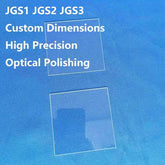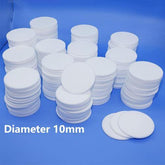How to reduce the influence of the birefringence effect of sapphire on optical applications
Sapphire, a transparent material with unique physical properties, has been extensively utilized in the field of optics due to its advantageous characteristics, including high hardness, strength, and thermal conductivity. However, the birefringence effect of sapphire exerts a certain influence on optical applications, which is a significant issue that must be considered in optical design and manufacturing.
1. Birefringence effect
Birefringence effect refers to the phenomenon whereby light passing through certain crystals, it is decomposed into two beams of light with mutually perpendicular vibration directions and different propagation speeds. Sapphire, a material that exhibits birefringence effect, has a birefringence of 0.008-0.10. Despite its relatively low level, it remains a significant factor in high-precision optical applications.
2. Influence on optical application
(1) Focal length variation
The birefringence effect of sapphire has been demonstrated to induce alterations in the focal length of optical lenses, thereby affecting their focusing ability and imaging quality. It is imperative that the influence of the birefringence effect on the focal length should be given full consideration during the design process of sapphire lenses, and that the necessary corrections and compensations should be applied.

(2) Aberration and chromatic aberration
Furthermore, the birefringence effect of sapphire has been demonstrated to result in aberration and chromatic aberration in optical lenses. These factors have the potential to compromise the operational efficacy of optical lenses, necessitating meticulous consideration and adequate compensation during the design and manufacturing phases of lens production.
(3) Change of polarization state
Furthermore, the birefringence effect of sapphire has been demonstrated to induce a negligible alteration in the polarization state of transmitted light. This is a problem that requires special attention for optical applications that need to maintain a stable polarization state.
3. Solutions
In order to mitigate the impact of sapphire birefringence effect on its optical application, the following measures should be considered:
 (1) Materials selection
(1) Materials selection
With regard to optical design, there is the option to use a sapphire material with lower birefringence, or an alternative material featuring unique refraction or a smaller birefringence effect.
(2) Optical design
In the process of lens design, the influence of the birefringence effect can be reduced by optimizing parameters such as the shape and thickness of the lens. Furthermore, the adoption of special optical structure designs, such as achromatic lenses, has the potential to enhance the performance of the optical system.
(3) Manufacturing techniques
Adopting advanced manufacturing techniques such as ion beam processing technology allows control and optimization of the crystal structure and properties of sapphire, thereby reducing the influence of the birefringence effect. Furthermore, the surface of the lens can be coated with a layer of high refractive index material, thereby enhancing its optical performance.
 (4) Selection of optical axis direction
(4) Selection of optical axis direction
When using sapphire as an optical element, the direction of the optical axis must be perpendicular to the surface of the element in order to avoid the occurrence of birefringence. All crystals with birefringence effect do not undergo this phenomenon in one or two specific directions. These directions are known as the optical axis directions.
The birefringence effect of sapphire must be fully considered and compensated for in the optical design and manufacturing process, as it has a certain impact on optical applications. By implementing measures such as selecting appropriate materials, optimizing optical design, adopting advanced manufacturing processes, and choosing the correct optical axis direction, the impact of sapphire birefringence on optical performance can be effectively minimized, enhancing the overall performance and application effectiveness of the optical system. The development of materials science and optical manufacturing technology is progressing steadily, and it is anticipated that this will lead to a significant expansion of sapphire’s application in the optical field.






